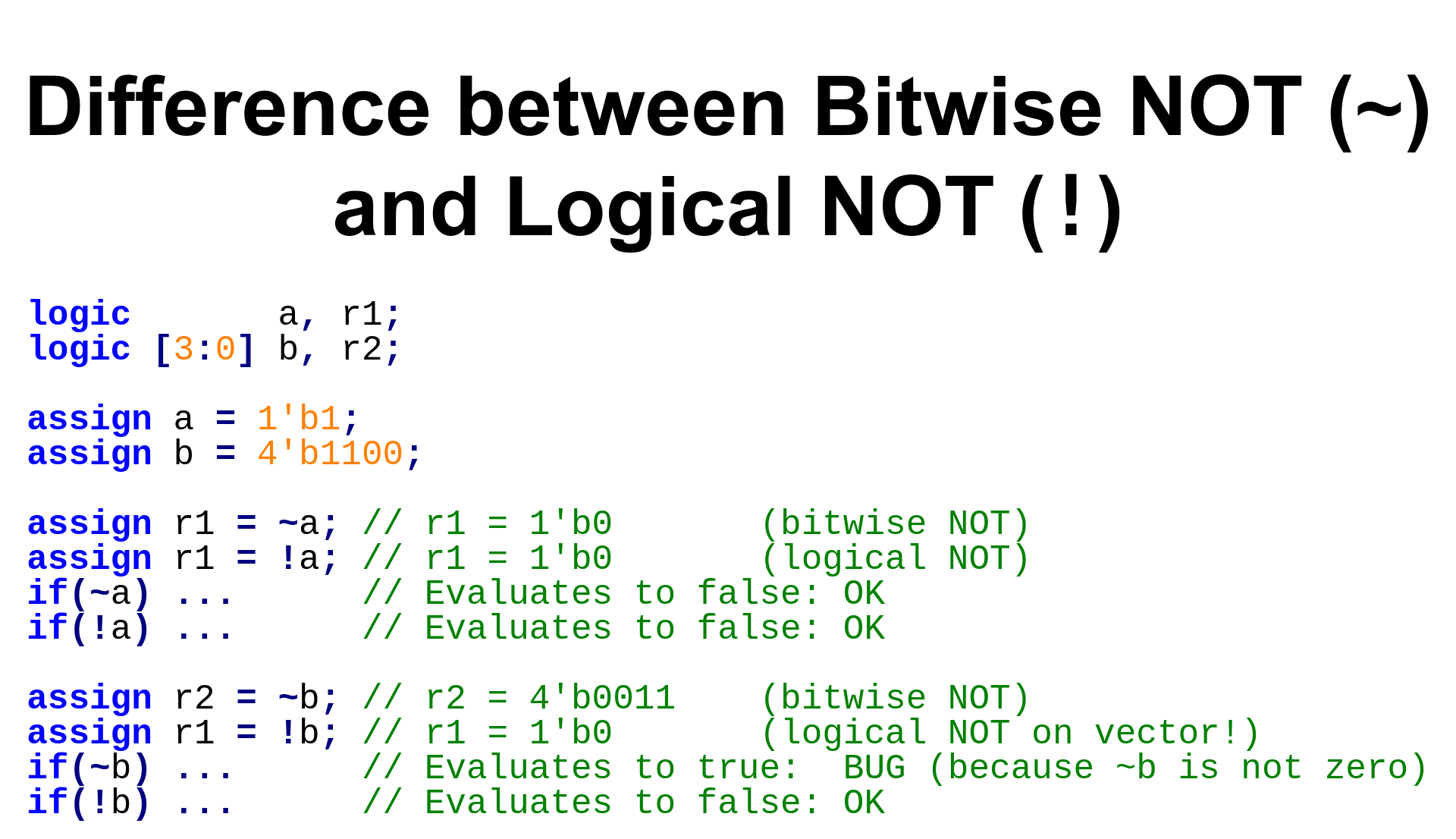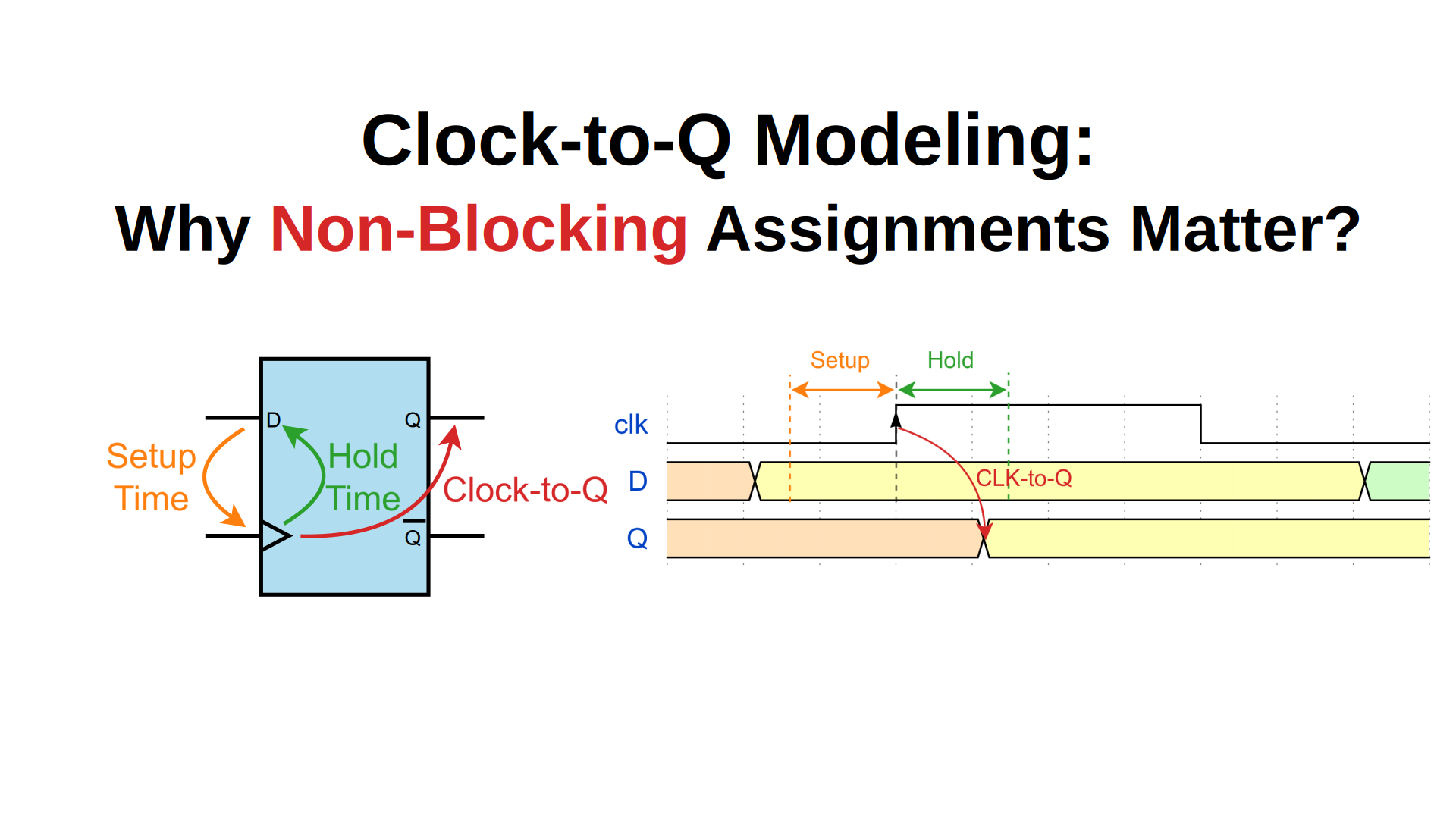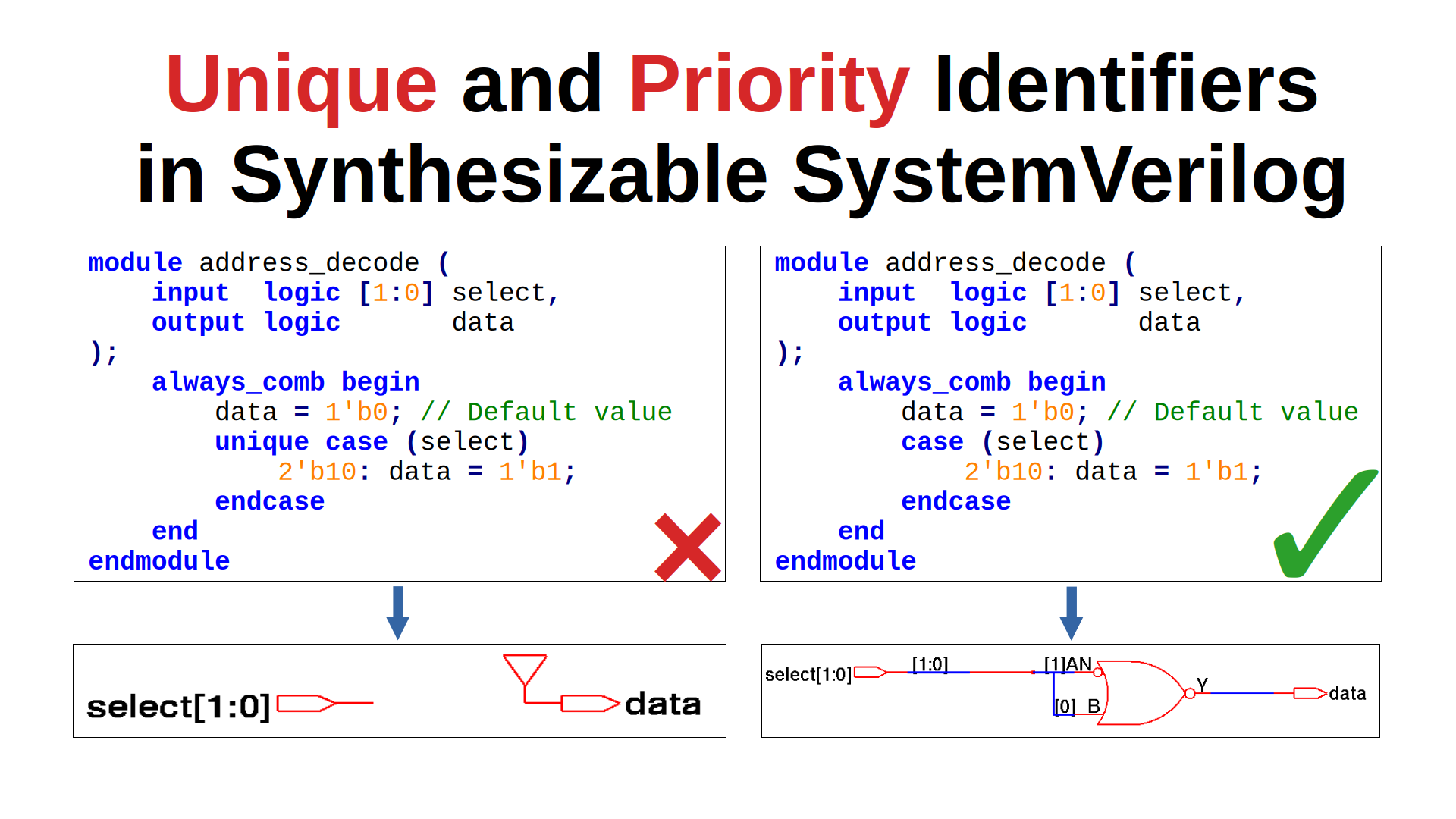SV12. Difference between Bitwise NOT (~) and Logical NOT (!)

When working with Verilog or SystemVerilog, it’s crucial to understand the distinction between the bitwise NOT operator (~) and the logical NOT operator (!). While they might seem similar, they behave differently and are intended for distinct purposes. Using them incorrectly can lead to subtle bugs that are hard to track down.
Video Tutorial
Watch this comprehensive video explanation of Difference between Bitwise NOT (~) and Logical NOT (!):
Quick Reference
| Operator | Name | Purpose | Input | Output | Use Case |
|---|---|---|---|---|---|
~ |
Bitwise NOT | Inverts each bit | Any width | Same width as input | Bit manipulation |
! |
Logical NOT | Logical negation | Any width | 1-bit (0 or 1) | Boolean conditions |
Detailed Explanation
Bitwise NOT (~) - Invert Operator
The bitwise NOT operator, also known as the “invert” operator, performs a bit-by-bit inversion of its operand. This means each 0 becomes a 1, and each 1 becomes a 0. The result will have the same bit width as the operand. This is also referred to as taking the one’s complement.
Key Characteristics:
- Inverts each individual bit of the operand.
- Returns a value with the same bit width as the operand.
When to Use ~:
- Use
~only when you need to invert the individual bits of a vector or a scalar value.
When NOT to Use ~:
- Do not use
~for evaluating logical true/false conditions, especially with multi-bit vectors, as it can lead to unexpected behavior. If any bit in the inverted vector is1, the condition will evaluate to true.
Example:
logic [3:0] data = 4'b1100;
logic [3:0] result = ~data; // result = 4'b0011
Logical NOT (!) - Negate Operator
The logical NOT operator, also known as the “negate” operator, is used for logical negation. It first performs a “reduction OR” on all bits of its operand. If any bit in the operand is 1 (true), the reduction OR results in 1. If all bits are 0 (false), the result is 0. If there’s an X or Z and no 1, the result is X. The logical NOT operator then inverts this single-bit result.
Key Characteristics:
- Performs a reduction OR on the operand to get a single 1-bit value (0 for false, 1 for true, X for unknown).
- Inverts this 1-bit result.
- Always returns a 1-bit value:
1'b1(true),1'b0(false), or1'bx(unknown).
When to Use !:
- Use
!only to negate the result of a logical expression or a value that represents a true/false condition.
When NOT to Use !:
- Do not use
!if your intention is to invert all bits of a multi-bit vector. It will reduce the vector to a single bit before negation.
Example:
logic [3:0] data = 4'b1100;
logic result = !data; // result = 1'b0 (because data is not all zeros)
Best Practices
Correct Usage
Use ~ for bit manipulation:
logic [7:0] mask = 8'b11110000;
logic [7:0] inverted_mask = ~mask; // 8'b00001111
Use ! for logical conditions:
logic enable;
if (!enable) begin
// Execute when enable is false
end
Common Mistakes
Don’t use ~ for logical conditions on multi-bit values:
logic [3:0] count = 4'b0001;
if (~count) begin // BUG: ~count = 4'b1110, which evaluates to true!
// This will execute unexpectedly
end
Don’t use ! for bit inversion:
logic [3:0] data = 4'b1100;
logic [3:0] result = !data; // BUG: result = 1'b0, not 4'b0011
Complete Code Example
module not_operators_example;
logic a, r1;
logic [3:0] b, r2;
initial begin
// Initialize values
a = 1'b1;
b = 4'b1100;
// Bitwise NOT on 1-bit value
r1 = ~a; // r1 = 1'b0 OK
r1 = !a; // r1 = 1'b0 OK (both work for 1-bit)
// Conditional checks on 1-bit value
if (~a) $display("~a is true"); // false OK
if (!a) $display("!a is true"); // false OK
// Operations on multi-bit value
r2 = ~b; // r2 = 4'b0011 OK (bitwise invert)
r1 = !b; // r1 = 1'b0 OK (logical negate)
// Conditional checks on multi-bit value
if (~b) $display("~b is true"); // true BUG!
if (!b) $display("!b is true"); // false OK
// Correct way to check if all bits are zero
if (b == 4'b0000) $display("b is all zeros");
// Correct way to check if any bit is set
if (|b) $display("b has at least one bit set");
end
endmodule
Guidelines Summary
When to use ~ (Bitwise NOT):
- Inverting individual bits in a vector
- Creating bit masks
- One’s complement operations
- Never use for logical true/false conditions on multi-bit values
When to use ! (Logical NOT):
- Negating boolean results in conditional statements
- Converting any value to a single-bit true/false result
- Never use for bit inversion of multi-bit values
For Vector Comparisons:
- Use equality operators:
==,!= - Use relational operators:
<,>,<=,>= - Use reduction operators:
|,&,^for specific bit operations
Memory Aid
Think of it this way:
~= “Flip bits” (bitwise operation)!= “Is false?” (logical operation)
Following these guidelines will help you avoid common pitfalls and write more reliable SystemVerilog code.




